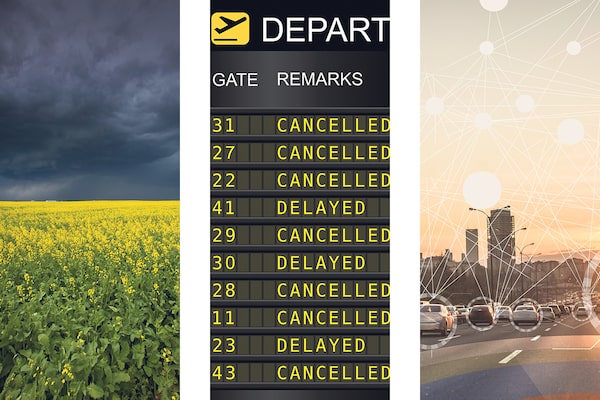
Innovative insurance solutions make it easier for customers to be compensated; for example, when farmers’ crops are affected by adverse weather conditions or when travellers’ flights are delayed. And sensor technology enables insurance providers to encourage and reward safe driving behaviour.
As consumers demand more choices, convenience, speed and transparency from insurance providers, industry leaders are responding. Parametric insurance solutions enable automatic payouts without time lag or paperwork; for example, a traveller with such insurance will be immediately compensated should an airline system that monitors take-offs confirm a specific flight delay. Similarly, farmers with crop insurance that leverages data from weather surveillance platforms can be automatically reimbursed in the event that adverse weather events such as hailstorms are recorded in the insured farmer’s area.
“Customers can be compensated based on a set of parameters without having to file a claim,” says Doug Grant, partner at Insurance-Canada.ca Inc., an organization providing independent information about technology and the business of insurance. “But insurance can also take a more active role. By combining technology like sensors with the internet as well as mechanisms for dealing with large amounts of data, such as AI, insurance organizations have the tools for managing risks rather than just helping someone recover from a loss.”
As sensors are paired with the Internet of Things, they enable real-time monitoring and feedback opportunities, and these capabilities are transforming the insurance industry from a system primarily dedicated to indemnification to one that includes loss prevention and management, says Mr. Grant. For example, when smart home systems detect a faulty water pipe, they automatically shut off water sources to minimize the damage and notify homeowners and insurance providers.
Patrick Vice, partner at Insurance-Canada.ca Inc., says that the number of sensors gathering data is growing at an exponential rate. According to a Gartner Inc. analysis, the number of connected things is projected to rise from last year’s 8.5 billion to 20 billion in two years, he says.
Insurance organizations have the tools for managing risks rather than just helping someone recover from a loss.
— Doug Grant, Partner at Insurance-Canada.ca Inc
For example, vehicles currently have about 60 to 100 sensors on board, and this number is going to increase to 200 over the next two years, says Mr. Vice. Sensor feedback can provide valuable information for insurance providers and can also serve to monitor driving behaviour and encourage better performance.
Mr. Grant says, “The ability to translate data into advice for drivers on how to improve their driving and potentially reward them for safe habits is an example of technology enabling a more interactive relationship between insurance providers and customers.”
The same trend can be seen in the life and health insurance space, where wearable technology – such as Apple watches or Fitbits – create a platform for encouraging and rewarding healthy habits, says Mr. Vice. “The information coming from the sensors is shared by the insurance provider and the customer for the benefit of both.”
Insurance innovation is also providing solutions for emerging needs, says Mr. Grant. “Before ride-sharing or home-sharing such as Uber and Airbnb came along, you wouldn’t need to think about whether you were insured riding in someone else’s car or having someone stay at your place,” he explains. “The products that were developed to cover the insurance needs in these situations evolved alongside the same apps and technology that enable these new service models to succeed.”
AI and deep analytics capabilities can also help to identify where new products can be successfully implemented, says Mr. Vice. “In the last two or three years, market analysis has allowed insurance providers to bring overland flood insurance to the market.”
Mr. Grant believes insurance providers that look at new opportunities and embrace innovation – from new products or services to new ways of communicating, distributing or marketing – are better equipped to provide leading-edge services and gain a competitive edge in a fast-paced industry.
Advertising produced by Randall Anthony Communications. The Globe’s Editorial department was not involved in its creation.